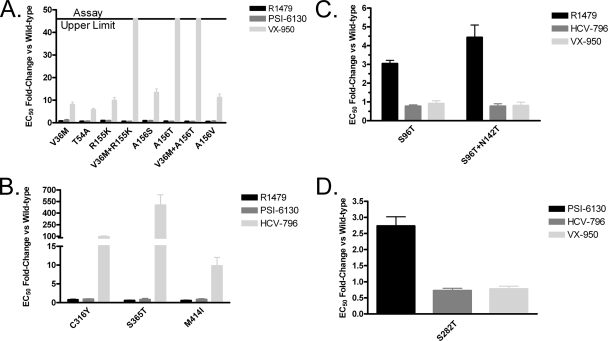FIG. 4.
Transient replicons show lack of cross-resistance to other classes of HCV inhibitors. Huh7-Lunet cells were transfected with either a wild-type GT 1b replicon or one engineered to contain mutations resulting in reduced sensitivity to VX-950 (A), HCV-796 (B), R1479 (C), or PSI-6130 (D). The transfected cells were incubated with various HCV inhibitors for 72 h, and then the replicon luciferase activity was measured. The EC50 determinations were obtained from at least three independent experiments: Con1, n = 6 for R1479, n = 8 for VX-950, n = 5 for PSI-6130, and n = 6 for HCV-796; V36M, n = 5 for R1479, n = 6 for VX-950, and n = 4 for PSI-6130; T54A, n = 4 for R1479 and VX-950 and n = 3 for PSI-6130; R155K, n = 3 for R1479 and PSI-6130 and n = 4 for VX-950; V36M+R155K, n = 5 for R1479 and n = 3 for VX-950 and PSI-6130; A156S, n = 5 for R1479 and PSI-6130 and n = 6 for VX-950; A156T, n = 4 for R1479 and n = 3 for VX-950 and PSI-6130; V36M+A156T, n = 3 for R1479, VX-950, and PSI-6130; A156V, n = 6 for R1479, n = 4 for VX-950, and n = 3 for PSI-6130; S96T, n = 6 for R1479, n = 8 for VX-950, and n = 4 for HCV-796; S96T+N142T, n = 6 for R1479, n = 7 for VX-950, and n = 4 for HCV-796; C316Y, n = 4 for R1479, n = 5 for PSI-6130, and n = 6 for HCV-796; S365T, n = 3 for R1479 and PSI-6130 and n = 5 for HCV-796; M414I, n = 4 for R1479 and n = 3 for PSI-6130 and HCV-796; and S282T, n = 6 for VX-950, n = 4 for PSI-6130, and HCV-796. The fold change of the inhibitor was determined as the EC50 of the inhibitor against the mutant replicon compared to the wild-type replicon and is presented as mean ± standard error of the mean.

